
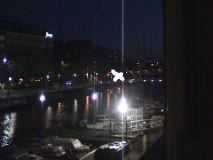
The Watershed (left) and the Arnolfini (right) viewed from each other
The cross roughly marks the ends of the wireless link.
This project and its write-up was a collaboration between Bristol Wireless and Psand.net


The Watershed (left) and the Arnolfini (right) viewed from each other
The cross roughly marks the ends of the wireless link.
Myself and Richard Higgs of Bristol Wireless (previously known as 'the Easton Community Local Area Network' or CLAN project) were contacted by Paul Clarke, an artist working on an innovative experiment funded by the bursary he had received from the The Reflective Practicioner research project, taking place across the South West and aimed at finding out how arts organisations could benefit the professional development of artists.
Together with Duncan Speakman, Paul was working on a project called Live Chat, with the intention of exploring relationships between real and virtual social spaces. The project was unusual, not only in the innovative approach to looking at the social relationships between cyberspace and realspace, but also in that it was to work simultaneously between the Watershed and the Arnolfini, two arts centres in the Bristol Harbour area.
The basic idea was that two actors would sit in the café bar of the Arnolfini and have a conversation that would be dictated to them through headsets. What was dictated would come from Paul and Duncan reading from IRC chat rooms, located elsewhere in the same building. The actors' conversation would be captured by a video camera, connected to a computer running QuickTime Broadcaster software and then streamed over a wireless connection to the Watershed (some 300 metres away across the harbour). In the Watershed's Digital Café, a machine would then read the stream and project it onto a large screen, so that people could watch the conversation live from across the water. There would also be iMac computers at the Watershed with IRC clients, so that spectators could log into the chat rooms and shape the conversation for themselves. The chat rooms were public access; meaning that anyone in the World could also be shaping the conversation, without necessarily being aware of it.
We (Rich and myself) were called in because they were having problems with getting a reliable wireless link established with the kit that they had, and because they'd seen the success of the Bristol Wireless, they felt that we could help.
The Live Chat event took place on the evenings of the 18th and 19th of December 2002.
From the brief, as I understood it when we first arrived at the Watershed, we were supposed to get a wireless connexion going between the Watershed and Arnolfini. As we'd been brought to the project fresh from working with the Bristol Wirless, I thought that a solid network design was required. This meant not just a wireless connexion, but also an optimised solution, making as good a use of the network as possible and establishing a solid security and network access policy for the link.
Another aspect that struck me immediately was that they were intending to use a dial-up connexion at the Arnolfini for the computer running the IRC chat client; this seemed to me to be the weak point in the experiment, given that dial-up connexions can be notoriously unreliable. The Arnolfini had no better Internet connexion than this, whereas the Watershed had a large fat pipe straight up to Bristol University. I thought as we were providing a wireless connexion between the two centres, that it would also be a good idea to provide an Internet gateway across it.
We cleared this with Oliver, the IT manager at the Watershed, and agreed that we would have MAC address level access control on the wireless gateway to stop the public being able to access their network. We used a Buffalo Technology AirStation 4 port router (model WLAR-L11G-L) at the Watershed with DHCP configured to give out IP addresses. This version of the AirStation has the ability to restrict access to known MAC addresses only and we added the addresses of the wireless cards in the laptops that we were using to test, as well as that of the card in the CLAN box to be used at the Arnolfini end. The Buffalo was then connected to a sector antenna mounted outside the building.
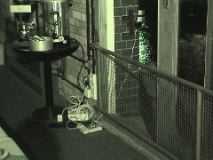
The Buffalo AirStation connected to sector antenna |

Close-up of the Buffalo AirStation |
At the Arnolfini end, we decided to use one of the DEC Multia from Bristol Wireless. These boxes have two PCMCIA card slots and one Ethernet port and are ideal for using as wireless-wireless or wireless-wired gateways. They are fondly referred to as CLAN boxes by the project and run Debian GNU/Linux. We connected this up to a sector antenna at the Arnolfini and used it to act like another router, providing DHCP to an Apple PowerMac G4 that was connected to the video camera. To measure signal strength we used the secure shell programme from a laptop to remotely login to the CLAN box and run the Wavemon wireless network monitor.
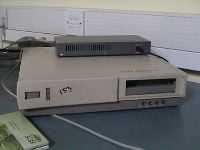
The CLAN box as used at the Arnolfini |
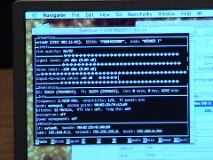
Monitoring the signal strength on the CLAN box using Wavemon |
The Watershed had a network address range of 192.168.1.2 - 254, with a default gateway of 192.168.1.1. The Buffalo was configured with an IP address of 192.168.1.254 on its WAN side interface, 192.168.0.1 on its LAN side and a DHCP server giving out addresses in the range 192.168.0.2 - 254. The CLAN box had an IP address of 192.168.0.2 on its wireless interface with a default gateway of 192.168.0.1, 10.10.10.1 on its Ethernet interface and a DHCP server giving out addresses of 10.10.10.2 - 254. The G4 broadcasting machine had an IP address of 10.10.10.2 with a default gateway of 10.10.10.1. Figure 1 below is a diagram of the network configuration as per our original design. All IP addresses used here are fictitious but are representative of the real configuration.
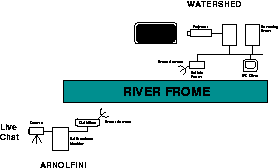
Network diagram (click to enlarge) |
Hewlett Packard had been doing some experiments with wireless at the Watershed as part of a larger project and had kindly allowed us to use the kit that they had. Therefore, apart from several Macintosh laptops that the Watershed already possessed, we also had a Lucent/Orinoco AP500 access point, a wand-shaped omni-directional antenna, a length of medium grade coaxial cable and a pigtail. After looking at this kit, and discovering that we did not have the password for the access point, we quickly decided to bring our own equipment and use the Buffalo access points that we had successfully used in the CLAN. It seemed that we would either use a combination of two sector anetnnae, two wave-guides or a wave-guide and a sector to achieve the link. We took GPS readings of the area and then left.
The next time we returned, we hit our first problem. Due to a lack of appropriate Health and Safety provisions, we were not permitted to walk along the shelf outside to mount the wave-guide to the flag pole! This was a problem, as we had decided to go down this route and so we were slightly stopped in our tracks.
We had however (luckily) brought with us a pre-fabricated Buffalo External high-gain sector antenna (model WLE-DA) and were able to fix this in a rather amateurish, but nonetheless pragmatic manner using gaffer tape to the outside of the building without having to physically go outside.
We then connected the long pigtail from the sector to the WaveLAN card that was inside of a Buffalo WaveStation 4 port router base station, which we had also brought with us and the Watershed side of the connexion was up and running. The sector was loosely orientated to catch the windows of the Arnolfini's café, away down the river, in it's beam.
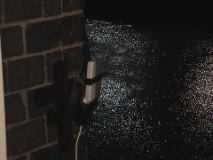
The sector antenna |
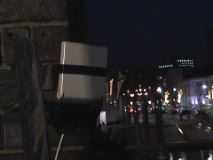
Close-up of sector antenna |
Then over to the Arnolfini to test the other end. We had great success (as usual) using an Apple iBook with AirPort card and the MacStumbler programme to get a signal. All the way to just outside the Arnolfini café we had signal strengths of over 25dB. However, as suspected, as soon as we tried to get access from inside the café we could not. The thick walls and recessed windows of the Arnolfini were causing the signal strength to immediately drop to zero!
We then tested the signal with a PowerBook G4 Titanium, famous for its rather poor antennae at either side of the machine. We were still able to get a good signal strength even with the built-in antennae. With a PCMCIA Buffalo WaveLAN card, using the Mac OS X WirelessDriver we had an even better signal. We left the scene feeling very positive and went to get a wave-guide cantenna and the cabling ready.
The Arnolfini has its café at street level with windows opening out onto the harbour-side at waist height. There are large window shelves both inside and outside. For this reason, we decided to fix a mounting bracket (in reality a triangular piece of wood with a wooden pole fixed to it) to the outside window frame in order to fit a wave-guide or sector antenna to this and keep the signal above head height. The other reason was to avoid having cabling across the street or generally available to be tripped-over by the general public.
We returned with the necessary items and a nice, newly-built wave-guide cantenna made using a Glenmorangie whiskey tin. We felt that perhaps Glenmorangie would offer us better reception than the J&B tins we'd used previously due to the improved quality of the whiskey that had been inside.
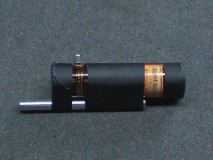
The 'Glentenna' (click for more images of Glentenna) |
To tell the truth, it was a nightmare! For some reason, all the URM67 cables, the connectors, pigtails, cantennae and even the wireless cards themselves, that day (which incidentally was the day of the event, just to add pressure) didn't appear to be working. We swapped things around, established what we thought was broken, and then things that weren't broken were, and vice versa! Needless to say it was time-wasting and frustrating.
However, after a trip to our local electrical spares supplier to get a female-female adaptor, we finally had a working connexion, using not the Glentenna that we were so proud of, but rather a home built bi-quad sector antenna. The combination of a sector at either end proved to be the most reliable choice. We think this was due to the number of trees and boat-masts in the way and also the fact that we did not have the ability to accurately align the Watershed's antenna because we were not permitted to step out of the window to do so.
We had the sector connected to a URM67 cable, connected to a female-female adaptor, to the Hewlett Packard pigtail going into one of our very own CLAN boxes, built on a DEC Multia PC. We were getting a good signal strength of around 28dB, network speed of 11Mbs and consistent and low ping times. We were there at last!
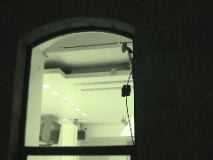
The sector antenna |
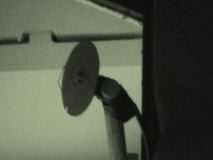
Close-up of sector antenna |
It was around an hour and a half before the event was due to start and we'd just managed finally to get a working and stable connexion. So we proceeded.
A Sony semi-professional video camera had been chosen for the event which was connected via Firewire to a Macintosh G4 tower running the QuickTime Broadcaster package. This package captures, compresses and streams the audio and video to a streaming server. It is free and really rather good. The G4 was connected to the DEC Multia, the signal leapt across the river to the Watershed and the Buffalo, which was connected to the internal network there and had access to the Internet. The video was then streamed to a server running QuickTime Streaming Server and then sent to a video screen.
It worked fine, or at least that's what we initially thought ....
What was happening was that the video stream on the big screen at the Watershed was bursty with the video freezing for a couple of seconds and then continuing. For some reason, that we were unaware of, the stream somehow clashed with some other streaming server running there or was perhaps being slowed down by something to do with the Internet connexion.
A disaster! It just would not do! Tempers were fraying and we were at a loss as to what to say or do. We needed a solution and we needed it fast!.
Well, it was simple really, or rather it was too complicated. We had based the design of the network along the lines of the CLAN project. We had installed two routers, employed MAC address-level access control, giving a fast Internet gateway across the river. Then we discovered that when the phrase point-to-point had been mentioned to us initially, this was not just referring to the antennae, but also to the network - to two machines basically with adjacent IP addresses connected directly together over a simple wireless connection.
So to solve this, we actually removed both the CLAN box and the Buffalo router and ended up installing HP's EP500 access point, which was configured to be a bridge and could not be reconfigured as anything else as we did not have Microsoft Windows to do it!
Not having PCMCIA slots in the G4 Tower, meant that this had to be replaced with an Apple iBook, with the keyboard lifted up to allow the pigtail to be plugged into the internal Airport card.
Within about an hour and lots of panicking and running between the two locations, we had it working without any of the extra bits in between, a straight connexion between the iBook running the broadcasting software and the machine in the Watershed running the player software and the video was working fine. However, this did pretty much wipe out a lot of the first night's performance.
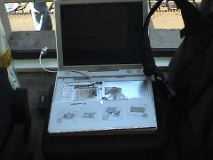
The pigtailed iBook |
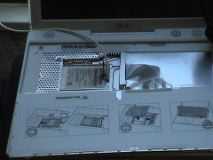
Close-up of pigtailed iBook |
For the second night the set-up was the same and it worked fine (albeit the iBook was a little slow at encoding) and the Live Chat project was a success. People that were in the Arnolfini's café that night were most entertained by the two actors having a very unusual conversation about all sorts of things and those in the Watershed logged into IRC and watched the screen with delight.
With the number of people involved, the lack of experience and the misunderstanding between us, as well as some difficult technical and bureaucratic obstacles, it was personally rather a nightmare. However, it did work in the end and proved to be an interesting use of technology (primarily video, streaming, Internet and wireless) with an unusual and original result. My hat goes off to those that conceived it.
Lastly, many thanks to Stuart Martin and John Honniball of HP Labs in Bristol, especially Stuart on the day of the 18th who was a great help in keeping us sane and came up with a beer just at the right moment!
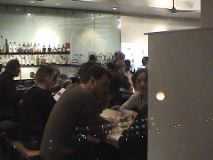
The Live Chat taking place |
At the end of the day the solution worked. We were able to do what was asked of us and facilitate connectivity. However, as mentioned above, not without a reasonable amount of stress and frustration. Here are my conclusions as to things that could be done better in the future.
Note: if you feel you have been left off the above credits list or if you wish to advise us of an error or inaccuracy in the text of this article, please email the author at the email address below.
* 'Frome' is pronounced 'Froom' and rhymes with 'Broom' and not 'Foam'.
Author: Mike Harris
Copyright (c) 2003 Psand Limited. Permission is granted to copy, distributed and/or modify this document under the terms of the GNU Free Documentation License, Version 1.1 or any later version published by the Free Software Foundation; with no Invariant Sections, with no Front-Cover Texts, and with no Back-Cover Texts. A copy of the license is included in the section entitled "GNU Free Documentation License".
wireless,802.11b,link,cantenna,can-tenna,sector,whiskey,onmi,omni-directional,omnidirectional,CLAN,Bristol,Frome,harbour,Arnolfini,Watershed,river,Psand.net,Internet,streaming,audio,video,QuickTime,QTTS,Darwin,Buffaol,HP,Hewlett-Packard,Apple,Mac,Macintosh,Multia,DEC,Live,Chat,Paul,Clark,Duncan,Speakman,Rich,Higgs,Mike,Harris,camera,client,server,microphone,cafe,actors,webcam,live,broadcast,Ethernet,transmissions,internet,public,access,connectivity,linux,free,Debian,GNU,software,psand,uk,europe,britain,internetwork,network,cables,project,projector,screen,chat,IRC,PCMCIA,headphones,headsets,screen,PC,G4,PowerBook,Titanium,iBook,WaveLAN,Airport,compliant,interesante,Psand,Easton,comms,communication,services,consultants,consultant,bandwidth,art,NAT,port-forwarding,filters,University of Bristol,Matrix,Reflective,Practitioner,Bursory,Heidi,Morstang,South,West,Arts,CreativePeople,Quick,Time,Sony,Bristol,Frome